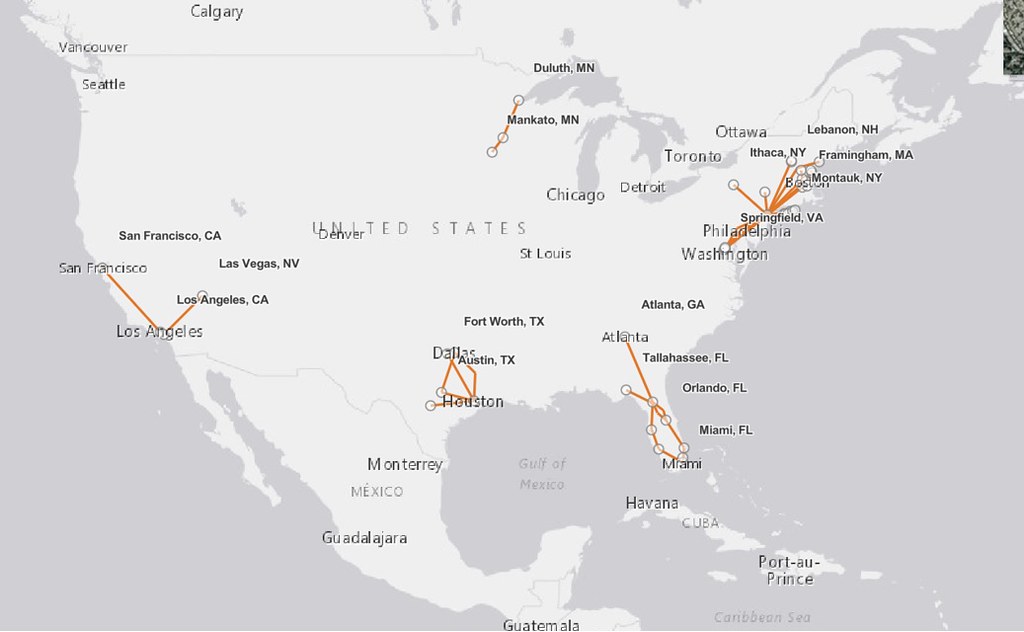
During a summer vacation season marked by long security lines and record-setting air traffic, it is easy to overlook a trend in U.S. ground travel that is winning converts from those who would otherwise fly: the rapid expansion of bus lines offering first- and business-class service on short-hop routes. These carriers, many of which have onboard attendants, snack and beverage service, and low-density seating, are a far cry from the conventional intercity bus lines that most business travelers are loath to use. Most offer frequent traveler programs and reserved seats like airlines. They also offer more spacious “2 x 1” seating (one seat and two seats on opposite sides of the aisle).
In the past year-and-a-half, six new premiums brands emerged, bringing the total number of premium services to 16, and several existing carriers have stepped up their game. The interactive map from my study, New Directions: 2019 Outlook for the Intercity Bus Industry in the United States, co-written with Brian Antolin and Matthew Jacques, shows that these services can now be found in the Mid-Atlantic Region, Minnesota, and New England, Texas, as well as the Southeast and Southwest. Not to be confused with traditional airport shuttle buses, the carriers mostly specialize on routes of 150 – 300 miles, which are awkward for flying, but uncomfortable for driving, particularly in heavy traffic.

Interactive map of Premium Bus Lines in the United States. Click here to access an interactive map showing routes and amenities.
Dallas-based Vonlane is a clear leader, having well-upholstered 22-seat buses that run 3 - 4 times daily in each direction on the Texas Triangle. An on-board attendant dispenses pillows and blankets, serves snacks and beverages (the company has a liquor license, a rarity for a bus line), and offers meals on certain trips, including salads, sandwiches, and wraps. A conference room is available for business meetings. The normal Dallas - Houston fare is around $100, compared to walk-up airfares on Southwest of around $175. Last month, Vonlane expanded Austin - Houston service to eight times daily.
The newest carrier, Landline, launched a “nonstop shuttle” between Minnesota airports in March. Landline has many similarities to an airline, with waiting areas akin to airport gates, complementary snacks and free Caribou Coffee. Travelers taking any of its four or five daily trips in each direction between the airports in Mankato and Duluth to Minneapolis - St. Paul International Airport have reserved seats and accumulate frequent travelers points. Landline is touting that more routes and an “interline” agreement allowing passengers to make bus/plane connections on single ticket will soon be unveiled.
Among the most exciting carriers to follow is Florida’s RedCoach, which has gradually expanded its core route system stretching from Miami to Tallahassee. A few months ago, Red Coach expanded north to Atlanta using first-class buses that have leather seats that recline to an almost horizontal position, and a state-of-the-art entertainment system.

Concord Coach Plus, featuring 2 + 1 seating, enhanced entertainment options, and onboard snacks and beverages.
The range of options is greatest, however, in the Northeast. LimoLiner caters to comfort-oriented travelers between New York and Boston, typically runs three times daily. It is notable for having hot towel service, a wide variety of snacks, and full-flush toilets. Like that of the long-serving Hampton Ambassador, linking New York to Long Island, onboard attendants cater to customer needs. Between northern New England and New York, three bus lines – C&J, Concord Coach, and Dartmouth Coach – offer business-class service. Each offers snacks and beverages and 2 x 1 seating while allowing travelers to avoid time-consuming transfers between train stations in Boston.
Travelers on the New York – Metropolitan Washington route can choose among four options, but none has yet emerged as a frontrunner. BestBus launched its Prime service in August following similar rollouts by Tripper Bus and Vamoose in 2017. In October, Washington Deluxe rolled out its own Lux Bus, which features larger seats with extra legroom. Fares bought on the day of departure are about $40, compared to $175 Amtrak’s Acela, although notable downsides include the roughly five-hour travel time, compared to less than three on the train, and a limited choice of departure times.

Snacks served by onboard attendant on Texas-based Vonlane. Complimentary meals are served on some trips. (Photo from vonlane.com)
The premium bus-service sector is still in its infancy. Large swaths of the country, including the lower Great Lakes Region, Mountain states, and Pacific Northwest, remains bereft – expect that to change. Vonlane, for one, has indicated that it hopes to expand beyond Texas.

A promotional image showing the amenities on first-class buses operated by RedCoach, which has an extensive Florida network and a new Atlanta, GA route. RedCoach is unusual for having dedicated first-class and business-class coaches, giving travelers a choice. (Image from redcoachusa.com)
Skeptical? Reread this thread while waiting in a long airport security line on your way to an avoidable short-hop flight. If you change your reservation, you’ll likely pay a $200 fee plus the difference in fare. On Limoliner, $20 or less. On Vonlane? No cost.
At a time when ridership growth on conventional bus services like Greyhound and Megabus has slowed, the expansion of America’s premium brands is a fascinating trend to watch.
Joseph Schwieterman, Ph.D., is professor of Public Services and director of the Chaddick Institute for Metropolitan Development at DePaul University in Chicago. He is co-author of New Directions: 2019 Outlook for the Intercity Bus Industry in the United States.
Photo: Via vonlane.com.












